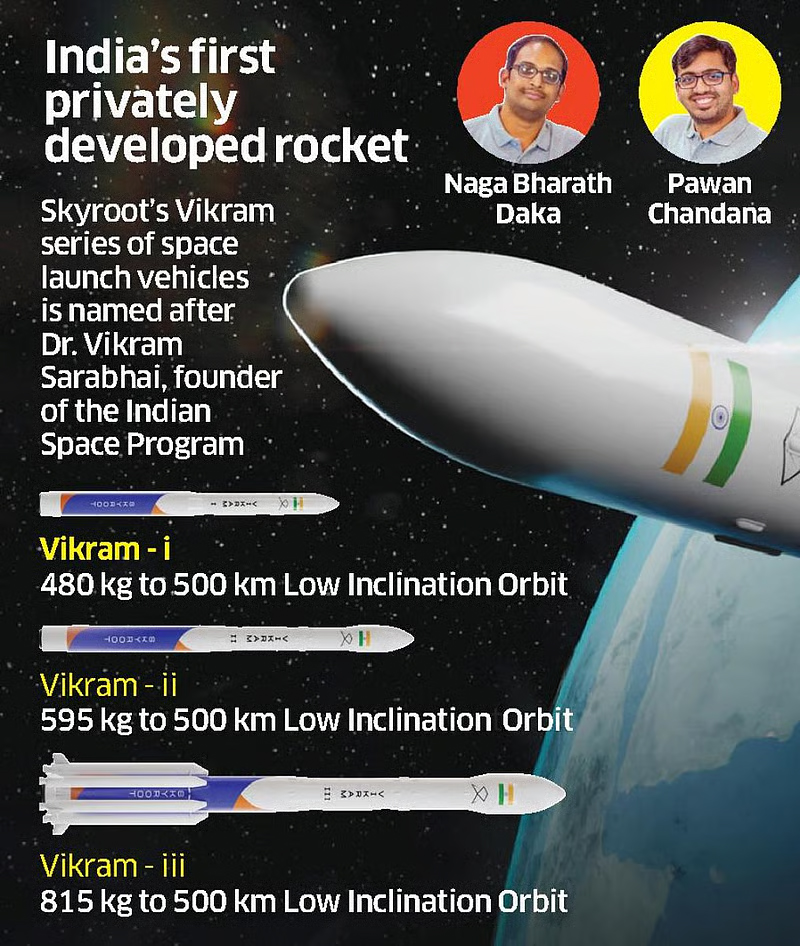Context:
Recently, Prime Minister of India formally unveiled Vikram‑I, the first orbital‑class launch vehicle developed by a private Indian enterprise, Skyroot Aerospace. The inauguration also marked the opening of Skyroot’s new “Infinity Campus” in Hyderabad. The launch vehicle is named after space pioneer Vikram Sarabhai — regarded as the father of India’s space programme.
Key Features & Capabilities of Vikram‑I:
-
- Orbital launch capability: Vikram‑I is designed to place small satellites into orbit, targeting both Low Earth Orbit (LEO) and Sun‑Synchronous Orbit (SSO). Depending on the mission profile, it can carry up to ≈ 350 kg to LEO or ≈ 260 kg to SSO.
- Flexible deployment: The rocket supports dedicated launches or rideshare missions, enabling deployment of multiple satellites — a feature especially relevant for small‑sat constellations.
- Modern design & efficiency: Vikram‑I uses an all‑carbon‑composite structure to reduce weight, combined with a blend of solid‑fuel boosters (for the initial stages) and a 3D‑printed liquid engine for the upper stage — offering reliability and cost‑effectiveness.
- Rapid turnaround & minimal infrastructure needs: The design reportedly allows assembly and launch within 24 hours from any suitable launch site, making it suitable for responsive and flexible launch requirements.
- Orbital launch capability: Vikram‑I is designed to place small satellites into orbit, targeting both Low Earth Orbit (LEO) and Sun‑Synchronous Orbit (SSO). Depending on the mission profile, it can carry up to ≈ 350 kg to LEO or ≈ 260 kg to SSO.
Significance of Vikram‑I for India’s Space Sector:
1. Private Sector Participation & Industry Growth
· Marks shift from government-only space activities to a hybrid model with private players.
· Encourages design, manufacturing, and operation of orbital launch vehicles by private companies.
· Promotes competition, innovation, and expands India’s presence in the global small-satellite market.
2. Boost to Small Satellite Ecosystem & NewSpace Economy
· Payload capacity and flexibility suitable for small satellites, Earth observation, communication microsats, and constellation deployments.
· Positions India to tap into the multi-billion-dollar global NewSpace economy.
3. Strategic and Commercial Autonomy
· Reduces dependence on foreign launch services.
· Enhances national space autonomy and lowers costs/time for satellite deployment.
· Benefits commercial operators, research institutions, and strategic sectors including defence.
4. Institutional and Policy Transformation
· Reflects impact of recent space-sector reforms facilitating private access to infrastructure, technology, and launch facilities.
· Skyroot’s Infinity Campus demonstrates realistic scalability with monthly rocket production capacity.
Challenges & Future Considerations:
· First launch performance and reliability.
· Meeting global standards for payload safety, cost, and scheduling.
· Regulatory compliance, material sourcing, and environmental clearances.
· Sustained government-private collaboration and transparent policies.
Conclusion:
Vikram‑I signify a transformative milestone in India’s space journey. It enables small-sat launches from India, encouraging private innovation, and building scalable launch capacity. This could usher in a new era of space entrepreneurship, self-reliance, and global competitiveness.







